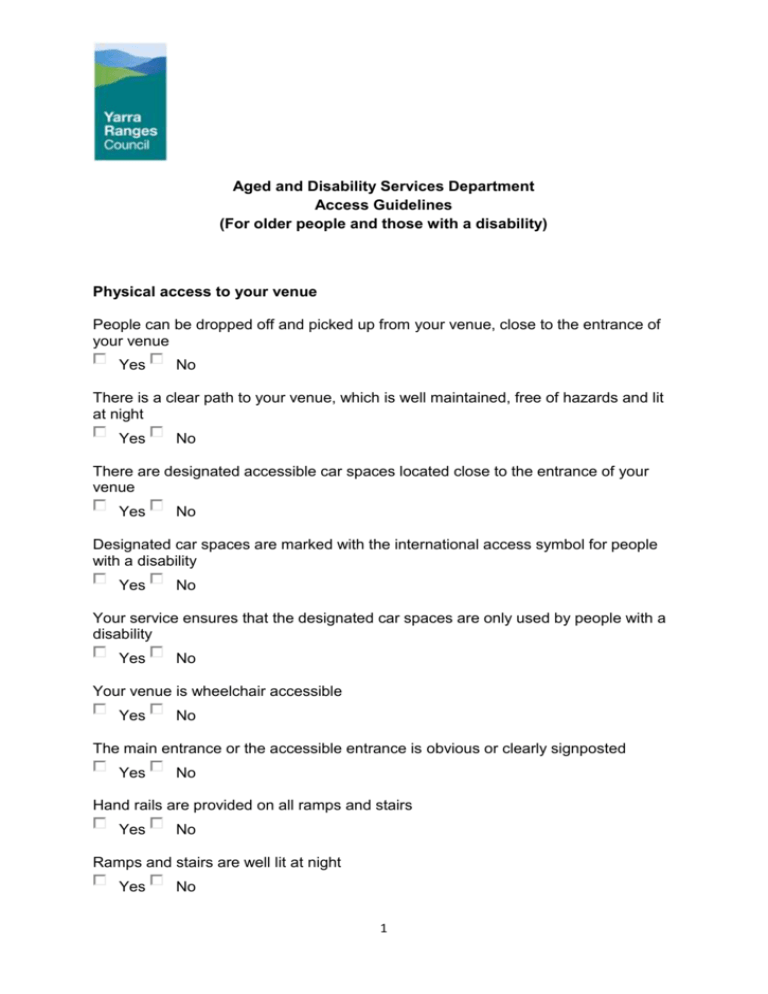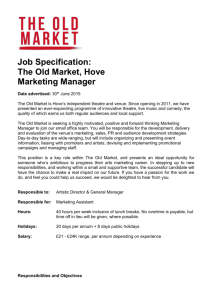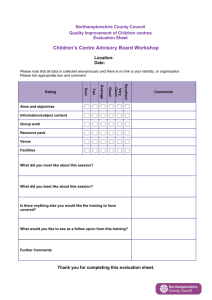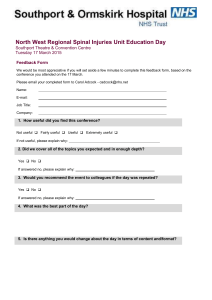Accessibility guidelines for older people
advertisement

Aged and Disability Services Department Access Guidelines (For older people and those with a disability) Physical access to your venue People can be dropped off and picked up from your venue, close to the entrance of your venue Yes No There is a clear path to your venue, which is well maintained, free of hazards and lit at night Yes No There are designated accessible car spaces located close to the entrance of your venue Yes No Designated car spaces are marked with the international access symbol for people with a disability Yes No Your service ensures that the designated car spaces are only used by people with a disability Yes No Your venue is wheelchair accessible Yes No The main entrance or the accessible entrance is obvious or clearly signposted Yes No Hand rails are provided on all ramps and stairs Yes No Ramps and stairs are well lit at night Yes No 1 Ramps are built according to disability standards, ie. not too steep Yes No Stairs are slip resistant Yes No Doorways are a minimum of 850mm in width Yes No Your venue and venue entrance is free of hazards that block pathways (such as bikes, school bags, brochure stands, plants) Yes No Floor surfaces are even and slip resistant Yes No Your venue uses colour differentiation between ceilings, walls, doors and floors Yes No Door handles, door bells, brochures and promotional material are at the right height for wheelchair users Yes No There are designated accessible toilets and change rooms Yes No Accessible toilets have a grab rail next to the toilet and there is enough room for a person to manoeuvre themselves from a wheelchair to the toilet. Taps and handrails are within reach of any wheelchair users Yes No Signs indicate all important features such as the reception, toilet Yes No Signs use symbols rather than words whenever possible. For example a symbol of a woman, rather than the word "women" on a toilet door. Yes No Signs use dark writing or symbols on a white background. Any writing is in a plain font such as Arial and is in a large point size Yes No If people need to wait for your service, seating is provided Yes No 2 You use warning signs for entertainment events that use strobe lighting or smoke machines Yes No Your service has transport arrangements for people who have difficulty in getting to your service Yes No Loop system available for hearing impaired people Yes No Quiet area for hearing aid/cochlear implant users Yes No Making your service more accessible is likely to make it safer and more accessible for other people who visit your service such as older people, people with a disability, young parents with prams, or people who cannot read English. It could also help you meet your public liability and workplace safety responsibilities. Promoting your service Promotional flyers use a dark coloured print on a light background, pictures, symbols and diagrams, a plain font such as Arial, at least 12 point font size (minimum for people with a visual impairment) Yes No Promotional flyers are easy to read, use basic English and no jargon Yes No Photos and drawings of people in promotional material feature a range of people, including older people and young people with disabilities. Yes No Promotional flyers state if you have wheelchair access Yes No Promotional videos accessible (captions) Yes No People can phone, SMS (text), email or fax your service, or your service has a TTY phone system. (A TTY phone system is designed for people who have a hearing or speech impairment. TTY works by sending typed messages between two people who have TTY phones). Yes No Your website meets disability standards Yes No 3 Alternate formats for written material – (Large print, audio) Yes No Staff and volunteer awareness Staff and volunteers know how to communicate with a person who is/has: Yes No - hearing impaired Yes No – non verbal (Auslan users) Yes No – speech impaired Yes No – visually impaired Yes No – has a learning difficulty or has an intellectual disability Yes No - brain injured Yes No – a mental health issue Have an awareness of using the National Relay Service, email and text chat options. 4






